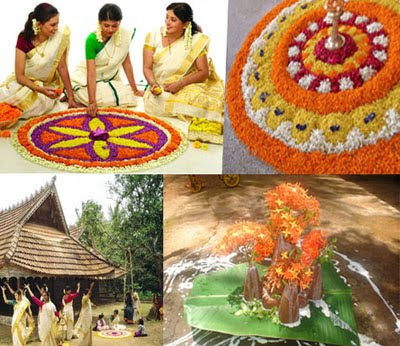Malayalees celebrate the festival of Onam.
 Keralites on Monday celebrated Onam, the spring festival commemorating the egalitarian utopia under the reign of mythical King Mahabali during which people lived in plenty, prosperity and equality.
Keralites on Monday celebrated Onam, the spring festival commemorating the egalitarian utopia under the reign of mythical King Mahabali during which people lived in plenty, prosperity and equality.People cutting across caste, class and religion decorated their homes with floral carpets to welcome the annual re-visit of Mahabali.
The legend has it that 'Asura' king Mahabali was banished to the netherworld by Lord Vishnu, who took the incarnation of Vamana (the dwarf), under pressure from 'Devas', who were jealous of the King's popularity.
Before his departure, the King secured an assurance from Lord Vishnu that he would be allowed to visit his subjects on 'Thiruvonam' day of Malayalam calendar every year.
The festivities scaled to its crescendo in the last couple of days with towns and villages thronged by men, women and children going out for their festive shopping.
The Significance Of Onam
Onam, is the most important and awaited festival of Kerala where the traditional aspects of the state unravels in fullest measure. Apart from being the harvest festival, ushering in a mood of celebration, it commemorates the golden reign of King Mahabali, the benevolent king of the Keralites.
Onam Festivities
Feast and festivities are a part of Onam.'Thiruvonam' falls in the month of August/September every year. Onam is celebrated for ten days. The cultural and traditional aspects of Kerala is joyfully and colourfully represented in the celebrations associated with it.
Pookalam, the multicoloured flower arrangements, Vallamkali, the snake boat race , the procession of caprisoned elephants and various dance forms like Kaikotti Kali, Thumbi Thullal, Pulikali, Kaduvakali, Kathakali etc are some of the important events that take place every year. The traditional Onam Sadhya, an array of delicious native Kerala dishes, spread on the banana leaf to be savoured is an integral and important part of the celebration.
The Symbolism in Onam
The story of King Mahabali highlights the element of self surrender. It represents the principle of Advaita Vedanta or Non-duality which is attained at the end of spiritual surrender. The gesture of king Bali surrendering himself to the Lord represents total surrender. The Lord placing his feet on the head of King Bali is symbolic of crushing the ego or banishing the non self which is the ultimate end of all spiritual endeavours resulting in spiritual enlightenment.
The Lord Himself calls the King, 'Mahabali', 'Maha' meaning 'Mighty' and 'Bali' meaning 'Sacrifice'. Effortless sacrifice is one with surrender which brings forth enlightenment or oneness. Once when the ego is crushed, all that remains is pure bliss. The celebration of Onam thus marks the celebration of oneness with the supreme which results in ualloyed joy or bliss.




























0 comments:
Post a Comment
We encourage people to contact us with any comments regarding news or any other queries about this site. We will respond you respectively and promptly.
We are going to moderate comments only to avoid unwanted and spam messages.
Thanks for your interest ! ! ! ! ! ! !